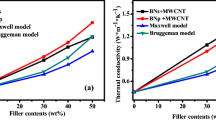Abstract
In this present study, effect of h-BN nanosheet on mechanical properties of polyethylene was studied using molecular dynamics-based approach. A reactive force field was used to predict the mechanical performance of polyethylene/BNNS nanocomposite. It was predicted from the simulations that fracture strength of pure polyethylene improved by 22% with an addition of 3wt% of BNNS. Furthermore, the interaction energy and toughness of nanocomposites increases with the addition of BNNS in PE matrix.
Access this chapter
Tax calculation will be finalised at checkout
Purchases are for personal use only
Similar content being viewed by others
References
Li X et al (2013) Exfoliation of hexagonal boron nitride by molten hydroxides. Adv Mater 25(15):2200–2204. https://doi.org/10.1002/adma.201204031
Sharma BB, Parashar A (2019)A review on thermo-mechanical properties of bi-crystalline and polycrystalline 2D nanomaterialsCrit Rev Solid State Mater Sci 0(0):1–37 https://doi.org/10.1080/10408436.2019.1582003
Sharma SS, Sharma BB, Parashar (2019) Mechanical and fracture behavior of water submerged grapheme. J Appl Phys 125(21). https://doi.org/10.1063/1.5088884
Sharma SS, Sharma BB, Parashar A (2019) Defect formation dynamics in dry and water submerged graphene nanosheets. Mater. Res. Express 6(7). https://doi.org/10.1088/2053-1591/ab19fc
Sharma BB, Parashar A (2020) Mechanical and fracture behaviour of hydroxyl functionalized h-BN nanosheets. J Mater Sci 55(8):3228–3242. https://doi.org/10.1007/s10853-019-04163-7
Zunger A, Katzir A, Halperin A (1976) Optical properties of hexagonal boron nitride. Phys Rev B 13(12):5560–5573. https://doi.org/10.1103/PhysRevB.13.5560
Baowan D, Cox BJ, Hill JM (2008) Junctions between a boron nitride nanotube and a boron nitride sheet. Nanotechnology 19(7). https://doi.org/10.1088/0957-4484/19/7/075704.
Slotman GJ, Fasolino A (2013) Structure, stability and defects of single layer hexagonal BN in comparison to grapheme. J Phys Condens Matter 25(4). https://doi.org/10.1088/0953-8984/25/4/045009
Meng J, Tajaddod N, Cranford SW, Minus ML (2015) Polyethylene-assisted exfoliation of hexagonal boron nitride in composite fibers: a combined experimental and computational study. Macromol Chem Phys 216(8):847–855. https://doi.org/10.1002/macp.201400585
Sharma BB, Parashar A (2019) Atomistic simulations to study the effect of grain boundaries and hydrogen functionalization on the fracture toughness of bi-crystalline h-BN nanosheets. Phys Chem Chem Phys 21(24):13116–13125. https://doi.org/10.1039/c9cp01661a
Sharma BB, Parashar A (2019) Atomistic simulations to study the effect of water molecules on the mechanical behavior of functionalized and non-functionalized boron nitride nanosheets. Comput Mater Sci 169:109092. https://doi.org/10.1016/j.commatsci.2019.109092
Kumar R, Parashar A (2017) “Fracture toughness enhancement of h-BN monolayers via hydrogen passivation of a crack edge. Nanotechnology 28(16). https://doi.org/10.1088/1361-6528/aa6294
Sahputra IH, Echtermeyer AT (2013) Effects of temperature and strain rate on the deformation of amorphous polyethylene: a comparison between molecular dynamics simulations and experimental results. Model Simul Mater Sci Eng 21(6). https://doi.org/10.1088/0965-0393/21/6/065016
Chaurasia A, Verma A, Parashar A, Mulik RS (2019) Experimental and computational studies to analyze the effect of h-BN nanosheets on mechanical behavior of h-BN/polyethylene nanocomposites. J Phys Chem C 123(32):20059–20070. https://doi.org/10.1021/acs.jpcc.9b05965
Rahman R, Foster JT (2014) Deformation mechanism of graphene in amorphous polyethylene: a molecular dynamics based study. Comput Mater Sci 87:232–240. https://doi.org/10.1016/j.commatsci.2014.02.023
Hossain D, Tschopp MA, Ward DK, Bouvard JL, Wang P, Horstemeyer MF (2010) Molecular dynamics simulations of deformation mechanisms of amorphous polyethylene. Polymer (Guildf) 51(25):6071–6083. https://doi.org/10.1016/j.polymer.2010.10.009
Chawla R, Sharma S (2017) Molecular dynamics simulation of carbon nanotube pull-out from polyethylene matrix. Compos Sci Technol 144:169–177. https://doi.org/10.1016/j.compscitech.2017.03.029
Kumar R, Parashar A (2018) Effect of geometrical defects and functionalization on the interfacial strength of h-BN/polyethylene based nanocomposite. Polymer (Guildf) 146:82–90. https://doi.org/10.1016/j.polymer.2018.05.041
Chabba S et al (2007) Accelerated aging study of ultra high molecular weight polyethylene yarn and unidirectional composites for ballistic applications. J. Mater Sci 42(8):2891–2893. https://doi.org/10.1007/s10853-007-1617-7
Xu T, Farris RJ (2007) Comparative studies of ultra high molecular weight polyethylene fiber reinforced composites. Polym Eng Sci 47(10):1544–1553. https://doi.org/10.1002/pen.20876
Rahman R, Haque A (2013) Molecular modeling of crosslinked graphene-epoxy nanocomposites for characterization of elastic constants and interfacial properties. Compos Part B Eng 54(1):353–364. https://doi.org/10.1016/j.compositesb.2013.05.034
Lv C, Xue Q, **a D, Ma M (2012) Effect of chemisorption structure on the interfacial bonding characteristics of graphene-polymer composites. Appl Surf Sci 258(6):2077–2082. https://doi.org/10.1016/j.apsusc.2011.04.056
Li M, Zhou H, Zhang Y, Liao Y, Zhou H (2017) The effect of defects on the interfacial mechanical properties of graphene/epoxy composites. RSC Adv 7(73):46101–46108. https://doi.org/10.1039/c7ra08243f
Ramanathan T et al (2008) Functionalized graphene sheets for polymer nanocomposites. Nat Nanotechnol 3(6):327–331. https://doi.org/10.1038/nnano.2008.96
Nasrabadi AT, Foroutan M (2010) Interactions between polymers and single-walled boron nitride nanotubes: a molecular dynamics simulation approach. J Phys Chem B 114(47):15429–15436. https://doi.org/10.1021/jp106330c
Sainsbury T et al (2012) Oxygen radical functionalization of boron nitride nanosheets. J Am Chem Soc 134(45):18758–18771. https://doi.org/10.1021/ja3080665
Lee D, Lee B, Park KH, Ryu HJ, Jeon S, Hong SH (2015) Scalable exfoliation process for highly soluble boron nitride nanoplatelets by hydroxide-assisted ball milling. https://doi.org/10.1021/nl504397h.
Ahadi Z, Shadman M, Yeganegi S, Asgari F (2012) Hydrogen adsorption capacities of multi-walled boron nitride nanotubes and nanotube arrays: a grand canonical Monte Carlo study. J Mol Model 18(7):2981–2991. https://doi.org/10.1007/s00894-011-1316-9
Kumar R, Mertiny P, Parashar A (2016) Effects of different hydrogenation regimes on mechanical properties of h-BN: a reactive force field study. J Phys Chem C 120(38):21932–21938. https://doi.org/10.1021/acs.jpcc.6b05812
Meng F, Chen C, Song J (2017) Lattice trap** and crack decohesion in graphene. Carbon N Y 116:33–39. https://doi.org/10.1016/j.carbon.2017.01.091
Tsai DH (1979) The virial theorem and stress calculation in molecular dynamics. J Chem Phys 70(3):1375–1382. https://doi.org/10.1063/1.437577
Author information
Authors and Affiliations
Corresponding author
Editor information
Editors and Affiliations
Rights and permissions
Copyright information
© 2021 Springer Nature Singapore Pte Ltd.
About this paper
Cite this paper
Chaurasia, A., Parashar, A., Mulik, R.S. (2021). Enhancement in Mechanical Properties of Polyethylene Using h-BN Nanofiller. In: Saran, V.H., Misra, R.K. (eds) Advances in Systems Engineering. Lecture Notes in Mechanical Engineering. Springer, Singapore. https://doi.org/10.1007/978-981-15-8025-3_14
Download citation
DOI: https://doi.org/10.1007/978-981-15-8025-3_14
Published:
Publisher Name: Springer, Singapore
Print ISBN: 978-981-15-8024-6
Online ISBN: 978-981-15-8025-3
eBook Packages: EngineeringEngineering (R0)




